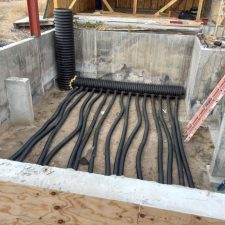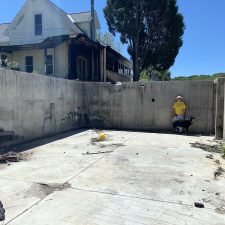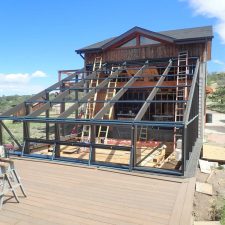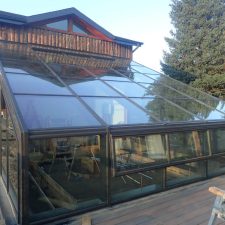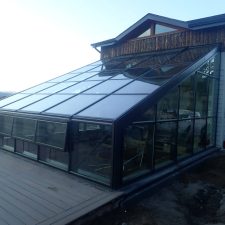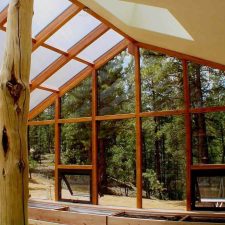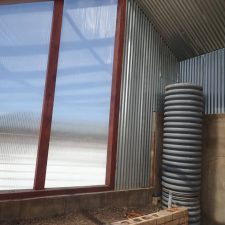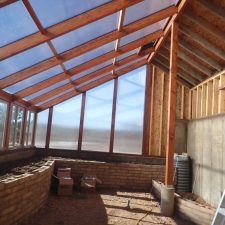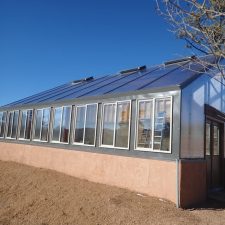Harnessing Nature's Energy: The Power of Passive Solar Greenhouses with a climate battery
As we continue to search for more sustainable ways to live, it’s important to look towards nature for inspiration. One such solution is the passive solar greenhouse. These greenhouses use the sun’s energy to regulate temperature and create a self-sustaining environment for growing plants year-round. Passive solar greenhouses are designed to capture and store heat from the sun during the day and release it at night. They are an innovative and environmentally-friendly solution that can help you reduce your carbon footprint while providing fresh produce all year long. In this post, we will explore the benefits of passive solar greenhouses, how they work, and what you need to know to build your own. So, let’s get started and learn how to harness the power of nature to grow healthy, sustainable food.
Throughout time and more so today than ever before, the desire and need to have and build a greenhouse has become a forefront priority in the plans for many families and related ventures.
Not just any greenhouse but an investment that will last year after year. A solar passive greenhouse creates a greenhouse effect that is highly appropriate for most types of plants to thrive throughout most seasons.
When built with the right components and building materials, growing all year long is remarkably realistic even in mountainous high altitude regions. Passive solar greenhouses leverage natural processes to maintain a comfortable and stable temperature inside. The design principles behind these greenhouses take advantage of the sun’s heat and light, as well as thermal mass, insulation, and ventilation, to create a self-regulating and energy-efficient space for plant cultivation.
The key feature of a passive solar greenhouse is its ability to capture and store solar energy. Large south-facing windows or glazing panels allow sunlight to enter the structure, warming the interior during the day. This solar radiation is absorbed by thermal mass materials such as concrete, stone, or water, which act as heat sinks, storing the energy and releasing it gradually during cooler periods.
The idea of installing 4” black corrugated tubing throughout the entire base floor of the structure is unique and very effective for circulating warm air underground, thus keeping rich growing soil from freezing.
Proper insulation and air circulation is crucial in passive solar greenhouse design, as it helps to retain the accumulated heat and prevent thermal losses. Insulating materials such as double-glazed windows, polycarbonate panels / sheets, or bubble wrap can be used to minimize heat transfer and maintain a consistent temperature inside the greenhouse.
Ventilation plays a vital role in passive solar greenhouses, allowing for the regulation of temperature and humidity. Thermostatically controlled operable ridge vents and operable windows strategically placed in the structure facilitate the exchange and flow of air, preventing overheating during sunny periods and ensuring adequate airflow for plant health.
In this particular project …. this 50 year old house had burnt down, providing an opportunity to re-build a new home while incorporating an effective heat climate battery by utilizing the existing concrete basement, a ready made environment for the perfect climate battery in a passive solar greenhouse.
To sum it all up here are the most important considerations when building a passive solar greenhouse.
- orientation – choosing the right location for your passive solar greenhouse – best fit is south facing
- glazing – quality clear glass and/or/with/ polycarbonate panels
- thermal mass – insulated north wall – in ground heat battery air tubes and fans and or water tanks
- ventilation – operable ridge vents, windows and circulating air fans
- Insulation – foam panels around concrete foundation walls
Overall, the benefits of passive solar greenhouses extend beyond environmental considerations. They provide a sustainable, cost-effective, and efficient solution for plant cultivation, allowing individuals to harness nature’s energy and create a thriving and Eco-friendly oasis. With these design factors, a passive solar greenhouse can harness the power of nature’s energy, providing a sustainable and efficient environment for year-round cultivation while reducing reliance on artificial heating and cooling methods.
The key is to realize and execute the necessary implementation of materials so that passive solar energy can be captured, retained and dispersed to achieve a controlled environment for growing vegetables and plants.
A freestanding greenhouse should run east to west with a south-facing wall and roof glazed to collect the maximum amount of energy from the sun. An insulated north wall is the best alternative to retain passive solar energy to minimize heat loss. A partially insulated roof with venting skylights / ridge vents that allow for natural convection during the warmer seasons. This is the perfect combination to be able to grow throughout most seasons. These features are what distinguish a passive solar greenhouse from ordinary ones.
Mechanical heating systems are a plus for any greenhouse… with the right selection of building materials and a cost efficient heater, helps a great deal if your planning to grow and sustain plant life … this holds true especially where climates can be brutally cold during winter months.
Contrary to popular belief the use of single pane clear glass versus double pane clear glass is a bit ambiguous. Double pane glass certainly has its place; however in a greenhouse, the use of single pane glass has just as much effect as does insulated double glass. The key is to properly seal your glass / glazing.
This is primarily due to the rapid temperature changes.
A tightly sealed structure with single glass and an insulated north wall and north roof can retain just as much heat if not more, than insulated glass does.
Both types of glass can also lose heat in cold days and nights, which is why the need for solar heat storage is extremely beneficial. Heating the soil and maintaining constant ground temperature is another important attribute of an active and or passive solar greenhouse.
A fully propagated greenhouse that has abundant plant life stores more heat than an empty or partially filled greenhouse.
Collected heat storage from other plants and heat collectors can radiate heat throughout the greenhouse keeping the temperature fairly constant.
Growing vegetables and plants is a very productive hobby and can be a great supplemental livelihood. It is good way to earn extra income by producing high-valued crops. It is also a good way of contributing to the environment. The best way to sustain this endeavor is to build a passive solar greenhouse.
Selecting and cultivating plants in a passive solar greenhouse
Passive solar greenhouses are designed to regulate temperature fluctuations naturally, but it is still necessary to choose plants that can tolerate these variations. Some plants, like tomatoes and peppers, thrive in warmer temperatures, while others, such as leafy greens in ground veggies like potatoes, carrots, beets, radishes and herbs, prefer cooler conditions. By selecting a diverse range of plant species with varying temperature requirements, you can maximize the productivity of your greenhouse throughout the year. Passive solar greenhouses are more than just a concept; they are tangible solutions that have been successfully implemented in various climates and regions. By harnessing the power of nature’s energy, these projects are not only providing fresh, locally grown food but also reducing carbon footprints and promoting a greener future.
How deep should climate battery tubes be for heated air to keep the ground soil at a constant temp.. ? A typical 3layer, 4”ADS tubing climate battery can be buried to about 3-5′ of depth. This allows for a deep layer at 3-5′ deep, a middle layer at 2-4′ ft depth , and a top layer at 1-2′, with 12” -16” of soil above it, for root zone and garden tools.
To learn more about the basics of a passive solar greenhouse or if your planning to build one …
please call …. 719 270 3000
Thoughts, questions please feel free to drop us a line

